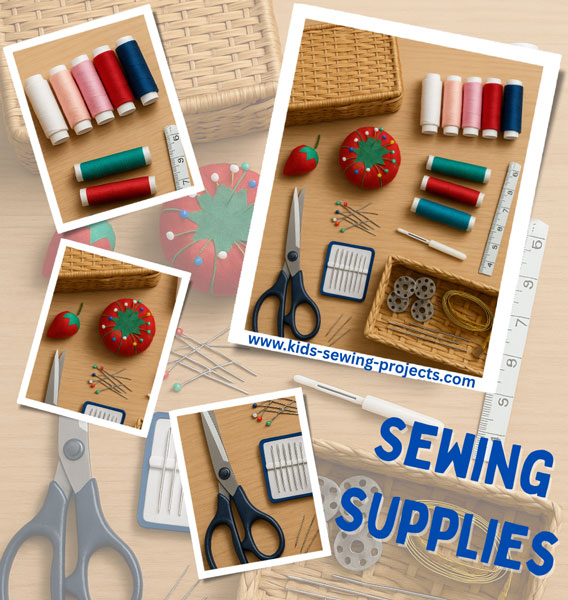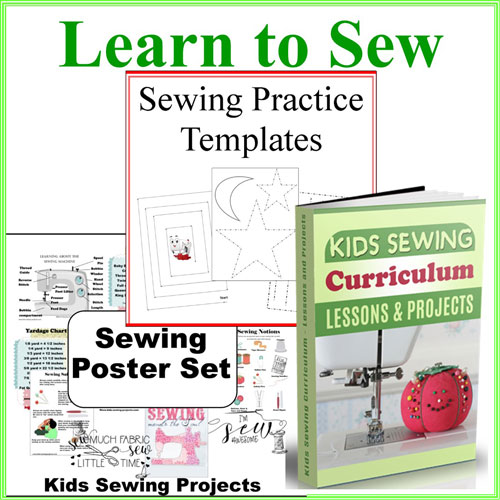- Home
- Supplies
- Basic Items
Basic Sewing Supplies
Before you start any sewing project, it's important to gather your basic sewing supplies. Having the right tools ready makes your sewing experience easier, safer, and more enjoyable.

Start by creating a special place to store your materials- Buy a simple box, plastic container or a special basket to store your machine supplies and hand stitching supplies. Keep your hand-sewing and machine-sewing tools together so you can easily find what you need. Over time, you can add new items as your skills and projects grow.Here are some ideas of basic items to stock your sewing kit.
Sewing Materials Available

Hand Sewing Supplies
If you're just starting out, begin with hand sewing. It helps you learn how stitches work before using a machine.- Hand needles
Buy a pack of assorted hand-sewing needles in different sizes. Thinner needles are great for light fabrics, while thicker ones work best for heavier materials like denim or felt. - Thread
Keep a variety of thread colors on hand so you can match your fabric. Start with basics like white, black, navy, and red-these cover most projects. - Pin cushion
You'll need a safe place to store your pins and needles. You can buy a pin cushion or make your own pin cushion. as a fun beginner project! - Scissors
Always use fabric scissors for cutting fabric. Avoid using them on paper, as that will dull the blades. Keep a second pair of scissors for cutting thread and patterns. - Pins and Clips
Straight pins or quilting pins help hold fabric together while sewing. Choose pins with large, colorful heads- they're easier for kids to handle and spot on fabric. - A seam ripper
Everyone makes mistakes while sewing! A seam ripper helps you remove stitches cleanly so you can fix errors without damaging your fabric.
Sewing Machine Supplies
Once you're comfortable with hand sewing, you can move on to using a sewing machine. A simple, sturdy beginner model is best-one that offers basic stitches like straight, zigzag, and backstitching without too many complicated features.- Sewing Machine
Once you've mastered hand sewing you will start learning to sew on the machine.Look for a machine that's easy to thread and operate. It doesn't need to be a child's machine-just a reliable beginner-friendly one. I recommend getting a simple machine not a children's machine. Buy a machine that can do lots of different stitches but not too complicated. - Thread
Depending on your project you will want thread to match your material. You don't have to match exactly however. Black or navy goes well on most dark fabrics and white can be used for most light materials. - Empty bobbins
You'll use the same thread colors you bought for hand sewing. Keep a few empty bobbins on hand so you can wind matching thread for your projects. - Extra machine needles
Machine needles come in different sizes. Lightweight fabrics need smaller needles; heavier fabrics need thicker ones. Keep extras ready in case one breaks while sewing. - Pins & Clips
Just like with hand sewing, you'll need pins or even better, fabric clips for thicker projects. Theyre great for kids and help keep fingers safe. - Measuring Tools
- Tape Measure: Great for taking body measurements or measuring large pieces of fabric.
- Clear Ruler: Perfect for cutting straight edges and aligning patterns. I use a quilting clear ruler to measure a lot.
- Fabric Marking Pencil or Chalk: Helps you mark sewing lines and pattern pieces without staining the fabric.
- Scissors
Don't forget your scissors from your hand sewing list above. - Iron and Ironing Board
Pressing your fabric makes a huge difference in how your finished projects look. Ironing seams flat helps everything fit and sew together neatly.
Setting Up Your Sewing Space
Having a clean, organized workspace helps you focus and enjoy your projects.- Choose a table or desk with good lighting.
- Keep scissors, pins, and small tools in containers or jars.
- Make sure there's space for cutting fabric, sewing, and pressing seams.
- Encourage kids to clean up after each project-it teaches responsibility and keeps supplies ready for next time!

**Don't forget to read your pattern or
instructions for items you will need.**
Optional Extras for Your Sewing Kit
As you gain experience, you may want to add:- Fabric glue or fusible tape (for quick fixes)
- Rotary cutter and cutting mat
- Extra bobbins in multiple colors
- Pattern weights
- Small brush for cleaning your sewing machine
Related Pages:
~Supplies,~ Kids Books, ~ Machines, ~ Notions Store,~ Kids Sew Kits, ~ Online Fabric Shops,~ Beginner Patterns,~ Kit in a Jar
Sewing Posters including a Sewing Supplies Poster available here:
Follow Kids Sewing Projects






